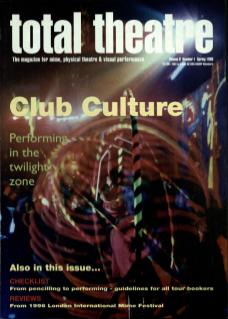Gary Stevens has been devising performances and touring his work throughout the UK and Europe since 1984. He doesn't have his own company as he prefers the freedom to work with different people. His most recent work to date is Sampler, in which an artificial world is created with sound and inhabited by six performers whose only way of discovering the structure of the world is by working out a sequence of movements to accompany the sound.
Gary moved into performance-based theatre after graduating in Fine Arts from Goldsmiths College, London. He has a conceptual approach to theatre, and his influences range from Laurel and Hardy and comic strips to the philosopher Wittgenstein. His work incorporates bizarre or unrealistic systems of logic to carry forward a story or event. His major preoccupation is with language. He strives to create visual images in the minds of his audience through playing with language, and presenting ideas in the form of game playing, or child's play. Gary's use of language is influenced by Wittgenstein, who wrote ‘... we must do away with all explanation, and description alone must take its place... [problems] are solved by looking at language in such a way that makes us recognize its working... the problem is solved not by giving new information, but by re-arranging what we already know.' This is what Wittgenstein called the Language Game.
Gary constructs and reconstructs language to create simple events that convey the complexities within ourselves and the world in which we live.
The overall theme of his work is centred on psychological responses to the restrictive environment in which we live. 'What I try to do is to unravel a representation of the mind by creating artificial personalities or constructs and then watch them form and deteriorate. Events that take place are controlled by a certain kind of logic which only makes sense within the piece, and as the audience begin to make sense of the event I explode that sense by introducing a new set of events.' There are no fully formed characters in the work, 'they are a bit like Laurel and Hardy, they are not quite people. This incompleteness creates an irresistible urge to fill in the gaps.' His work always begins with abstract ideas, 'I never really know how it will turn out until I begin to work it through with the actors... I let it develop in the way that it wants to go. My approach to theatre is sculptural, or like painting a portrait.'
Gary challenges his audience to use their imagination to understand the logic that gives meaning to a sequence of events, 'I do not confirm anything for the audience, I leave it to them to make up their own minds. Some people may read deeply into my work, others do not.' Two strong elements run through his work: his fear of the environment and of people.
Invisible Work (1984-1986) was a psychological drama which relied heavily on sound to create an alien environment which he describes as a 'complex psychological space where there was no reality principle'. This space was inhabited by performer Julian Maynard Smith, one of the founders of Station House Opera. His interaction with and response to these disembodied sounds drew him into what Gary describes as 'a dark obsessive game, which created a sense of extreme anxiety'. Different Ghosts (1987-1988) was located on a site shared by ghosts from three different eras. The present day character, played by Gary, was able to see the ghosts of the Victorian and Georgian era but they could not see him. The ghosts imposed on one another's space. Similarly, Invisible Work was concerned with the fear of an unknown or unseen phenomena over which we have no control, yet whose effects we can feel.
Gary's work is an examination of internal human experience. If the Cap Fits (1985-1987), performed with Caroline Wilkinson, was a serious exploration of alienation. A man and a woman were placed together like children in a play room. They did not know who they were or where they stood in relation to one another. A struggle for identity ensued. Each of the characters put on layer upon layer of clothes, reminiscent of children playing at dressing up. By the end the couple had become comical, misshapen figures. They reached out and tried to kiss each other but the barrier of clothing prevented them from getting close.
Gary Stevens' work is witty, engaging, entertaining and meaningful. It is also innovative and coherent in a mad sort of way. His work tells us that our freedom as human beings is being restricted by the world we have created for ourselves, which is rationalised and legitimatised by language. We are no wiser than Laurel and Hardy or cartoon characters if we are not allowed to meet our full potential as human beings.

